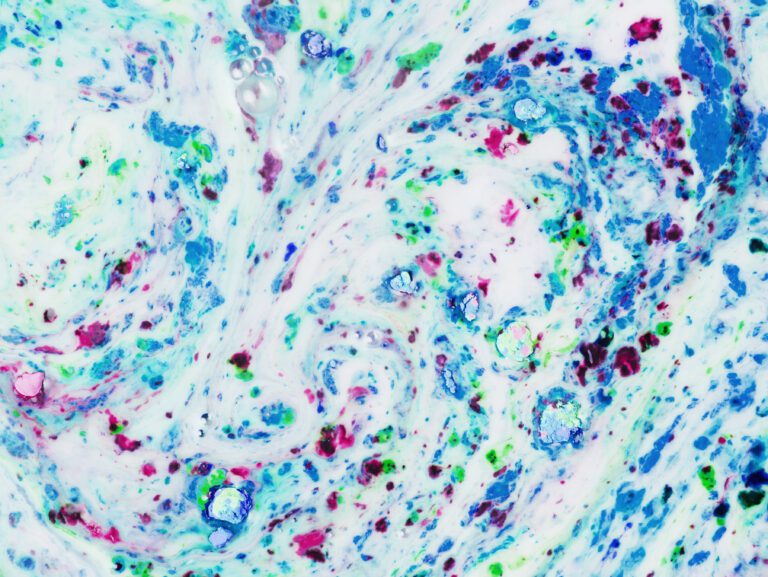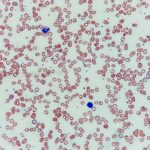
Complementary tests in hematology are vast and can be complex to understand. There are many diagnostic tools available for the assessment of patients in hematology. Interpreting the results of advanced testing and applying them to clinical practice are pivotal skills to develop. In this post, we will describe some of the most common and frequently performed tests by hematologists in clinical practice including:
Before proceeding, please, check out our previous publications regarding the diagnostic evaluation of patients in hematology:
- Laboratory assessment in hematology
- Evaluation of the peripheral blood smear
- Bone marrow biopsy in clinical practice
Hemoglobin Electrophoresis
Hemoglobin electrophoresis is a test used to isolate and identify the different types of hemoglobin present in a blood sample. Hemoglobin is a protein found inside the red blood cells responsible for carrying oxygen from the lungs to the body tissues and transporting carbon dioxide back to the lungs for exhalation. It consists of four protein subunits called globin chains, each containing a heme group that binds to oxygen molecules. In adults, there are two types of globin chains: alpha and beta-globin. A typical hemoglobin molecule contains two alpha-globin chains and two beta-globin chains.
- Alpha chains: There are two alpha-globin genes per chromosome (a total of four), allowing for the production of four alpha-globin chains. The alpha chains are encoded in chromosome 16. Mutations in alpha chains can be found in patients with alpha thalassemias.
- Beta chains: There is one beta-globin gene per chromosome (a total of two) allowing for the production of two beta globin chains. The beta chains are encoded in chromosome 11. Importantly, mutations in the beta-globin gene can lead to various hemoglobinopathies, such as sickle cell disease and beta-thalassemia.
There are other chains such as the delta and gamma chains but given that they are not as predominant in normal conditions, we will not describe them in detail.
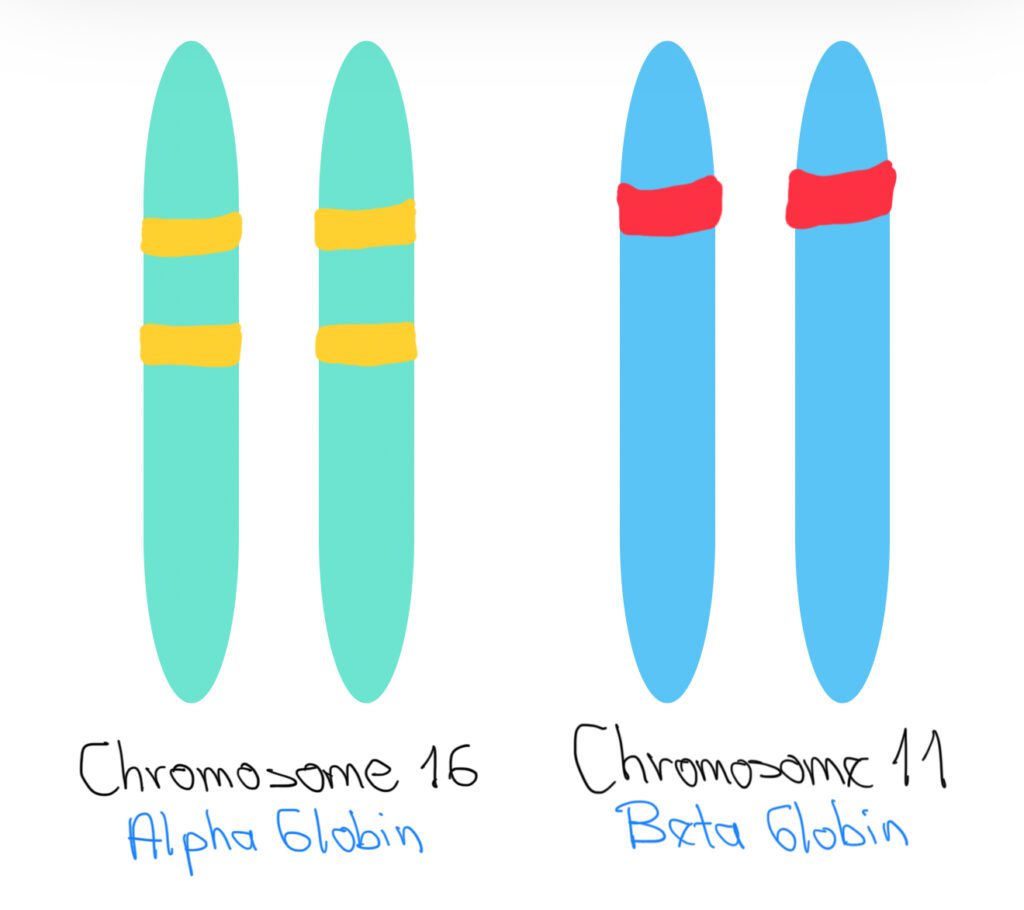
The Lego Story: Production of Hemoglobin by Combining of Alpha and Beta Chains
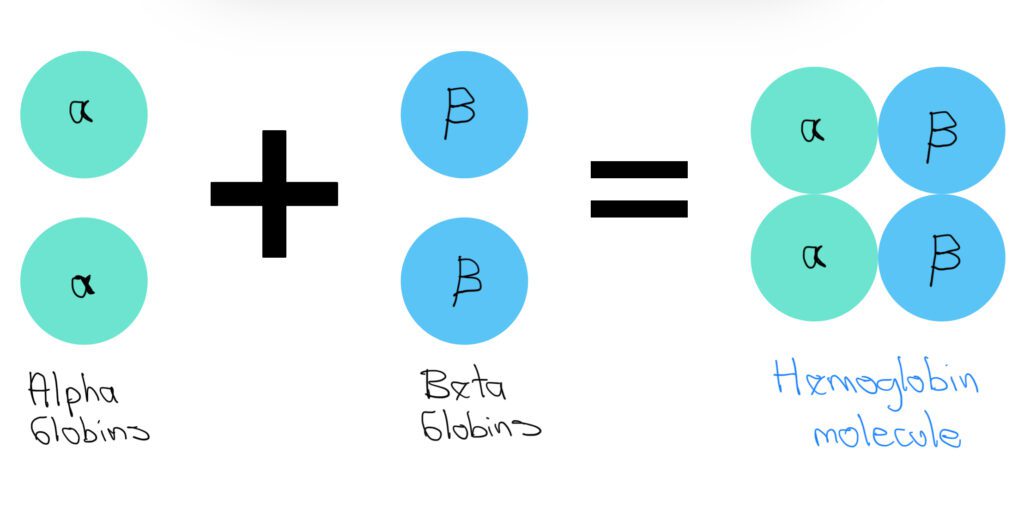
The combination of different globin chains forms different types of hemoglobin molecules. Think about Legos! Combining alpha and beta chains will produce different types of hemoglobin molecules such as hemoglobin A (HbA), which is the predominant form in adults. Each type of hemoglobin molecule has a different composition and functional characteristics:
| Hemoglobin Type | Chain Composition | Oxygen Binding Capacity | Percentage in Normal Conditions | Condition |
|---|---|---|---|---|
| Hemoglobin A (HbA) | 2 alpha (α), 2 beta (β) | High | 95-98% (predominant) | Normal |
| Hemoglobin A2 (HbA2) | 2 alpha (α), 2 delta (δ) | Moderate | 2-3% | Normal |
| Fetal Hemoglobin (HbF) | 2 alpha (α), 2 gamma (γ) | High | <1% | Fetal development |
| Hemoglobin S (HbS) | 2 alpha (α), 2 beta (β) | Low (polymerizes under low oxygen conditions) | <1% | Sickle cell disease/trait |
| Hemoglobin C (HbC) | 2 alpha (α), 2 beta (β) | High | <1% | Hemoglobin C disease/trait |
| Hemoglobin E (HbE) | 2 alpha (α), 2 beta (β) | High | <1% | Hemoglobin E thalassemia (rare) |
Performing a Hemoglobin Electrophoresis

The hemoglobin electrophoresis test is performed by running a peripheral blood sample through an electrophoresis gel. The different hemoglobin types can be separated based on their charge and size, allowing for the detection of the different types of hemoglobin. The hemoglobin electrophoresis test can help diagnose suspected hemoglobinopathies such as sickle cell disease, thalassemia, and others. The results of hemoglobin electrophoresis are reported by describing a percentage of all the different chains and hemoglobin types that help interpret if an abnormal hemoglobin pattern is present as seen in the picture above. We will discuss red blood cell disorders and hemoglobin abnormalities more in detail in future posts! Lastly, here is a video from Dr. Megren Alkhayatt describing hemoglobin electrophoresis:
Plasma Cell Dyscrasia Testing
The main function of the plasma cells is to produce antibodies also known as immunoglobulins which are crucial in immunity and defense against infection (particularly bacterial). Plasma cell dyscrasias are a group of disorders characterized by abnormal proliferation and function of plasma cells and include multiple myeloma, monoclonal gammopathy of undetermined significance (MGUS), and amyloidosis, among others. In these conditions, the plasma cells produce abnormal proteins in a disproportionately increased quantity (monoclonal proteins or M proteins). Importantly, an M protein means that there is a Monoclonal peak of a particular protein that is being produced more than the rest of the serum proteins. M protein is not the same as IgM which is one of the normal immunoglobulins. An M protein is pathologic. Clinical consequences in plasma cell dyscrasias come mostly from the accumulation of these “bad” proteins in the tissues causing damage.
Protein Electrophoresis
Similar to what was described in hemoglobin electrophoresis, proteins can be characterized by using gel electrophoresis to separate the different protein molecules according to their charge and weight. Protein electrophoresis is mostly performed in blood (serum protein electrophoresis or SPEP) and urine (urine protein electrophoresis). There are two main types of protein electrophoresis:
- Serum Protein Electrophoresis (SPEP): Using peripheral blood, this test separates proteins found in the serum into several fractions including albumin, alpha-1 globulins, alpha-2 globulins, beta globulins, and gamma globulins. Abnormalities in the gamma globulin region, such as the presence of an M protein spike, can indicate conditions like multiple myeloma or other plasma cell dyscrasias.
- Urine Protein Electrophoresis (UPEP): Similar to SPEP, UPEP separates and analyzes proteins present in urine. In hematology, the 24-urine protein test with UPEP is the most relevant one to perform, as it helps identify the presence of an abnormal protein in the urine and quantify it. Quantification of an M protein in urine is important in conditions such as multiple myeloma, monoclonal gammopathy of renal significance (MGRS), and amyloidosis.

One of the most helpful results obtained from serum protein electrophoresis is the quantification of the monoclonal protein peak (spike). The higher the M spike is, the more concerning the paraproteinemia is. For example, a patient with monoclonal gammopathy of undetermined significance could have a small M spike (usually <1 g/dL) versus a patient with multiple myeloma where usually the M spike is higher (usually above 3 g/dL). Similarly, an M spike can be measured in the urine. In clinical practice, the Bence Jones protein is measured in the diagnosis and monitoring of plasma cell dyscrasias. It can be detected through urine protein electrophoresis and immunofixation.
Immunofixation Electrophoresis (IFE)
In practical terms, when a protein electrophoresis test is performed, the results will note the presence of an M or monoclonal protein. However, the SPEP and UPEP will not describe the particular type of subtype abnormality. Immunofixation electrophoresis is a test usually performed after an SPEP or UPEP to provide more detail regarding which particular immunoglobulins or light chains are affected. In IFE, proteins separated by electrophoresis are transferred from the gel to a membrane and then incubated with specific antibodies that bind to different immunoglobulin types (e.g., IgG, IgA, IgM) or light chain types (kappa or lambda). The result would be the formation of visible bands on the membrane that correspond to the specific immunoglobulin or light chain present in the sample.

Immunofixation electrophoresis is particularly useful for distinguishing between monoclonal and polyclonal gammopathies (when more than one particular protein is being produced, likely a reactive process), as well as determining the specific subtype of monoclonal protein in conditions like multiple myeloma, Waldenström macroglobulinemia, and amyloidosis. An example of a result from SPEP and IFE could be that a “kappa monoclonal protein was found in the gamma region consistent with an IgG kappa monoclonal protein.”
Free Light Chain Assay

https://fr.wikipedia.org/wiki/UtiYohan
The immunoglobulins produced by plasma cells are composed of chains called heavy and light chains as seen in the image above. The light chains are produced by plasma cells as part of the normal immune response. However, their production could also increase in plasma cell dyscrasias. The assay typically involves the use of antibodies that specifically bind to free kappa and lambda light chains in the blood sample for quantification. The antibodies are labeled with fluorescent or enzymatic markers, allowing for the detection and quantification of the light chains. The free light chain assay is particularly useful in the diagnosis and monitoring of plasma cell dyscrasias. The goal of the test is to determine if there is an increased production of one of the two light chains kappa or lambda indicating a monoclonal process. Both kappa and lambda chains could be increased and usually indicate a reactive process such as the normal response to certain infections. In rare cases, both kappa and lambda could also be increased in plasma cell dyscrasias when more than one abnormal clone is present (rarely, there may be a population of abnormal plasma cells producing kappa chains and another abnormal population producing light chains).
The kappa-to-lambda ratio helps us understand the equilibrium between the kappa and lambda chains. In normal conditions, we produce slightly more kappa than lambda chains. Therefore, the kappa to lambda ratio (K/L ratio) is normally 0.26 to 1.65. If a K/L ratio is >1.65, there would be a suspicion of a plasma cell dyscrasia with kappa predominance. If the K/L ratio is <0.26, then we would consider a plasma cell dyscrasia with lambda predominance. Importantly, the kappa light chains are increased when there is renal dysfunction and the K/L ratio is higher depending on the degree of renal disease. It is important to adjust the ratio for renal function for accurate assessments. Finally, advanced age also affects the K/L ratio and age adjustment should be considered as well.
Flow Cytometry
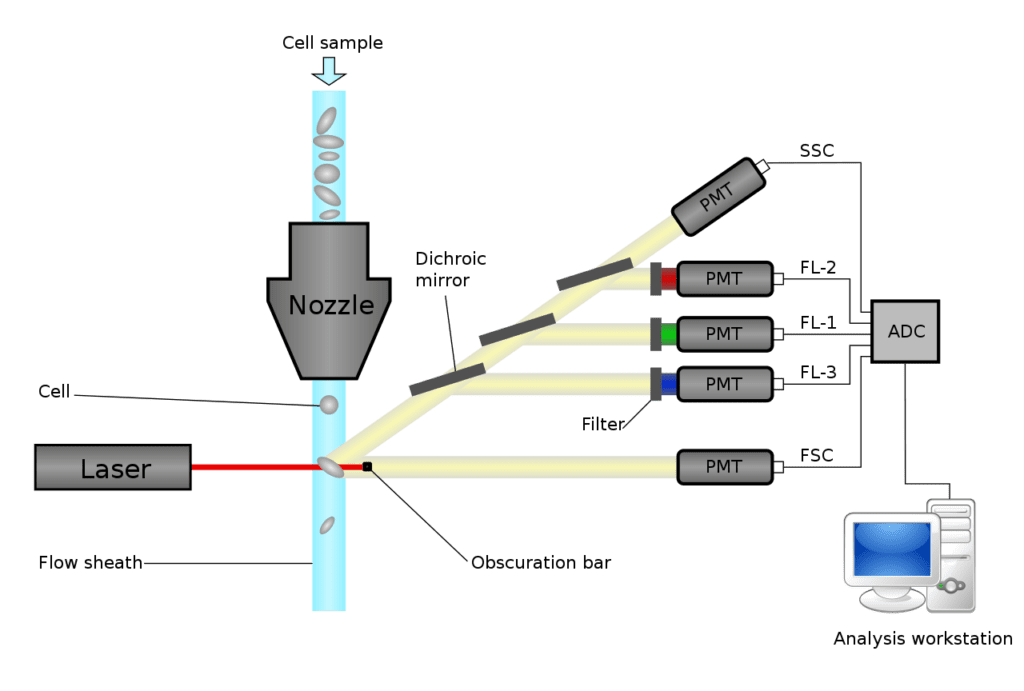
Flow cytometry is a powerful test that can be performed from peripheral blood to analyze individual characteristics of the blood cells. During microscopy, it is difficult to differentiate between the different types of cells. For example, it may be challenging to differentiate a B versus a T lymphocyte. A blood sample from peripheral blood can be used to perform this test. Many characteristics can be analyzed by flow cytometry including size, cell surface markers, intracellular proteins, DNA or RNA, and others.
The process of flow cytometry involves several key steps:
- Preparation: Cells of interest are collected from tissues or fluids and prepared for analysis. This may involve staining the cells with fluorescent dyes or antibodies that bind to specific cell surface markers, intracellular proteins, or DNA/RNA.
- Sample analysis: The prepared cell suspension is introduced into a flow cytometer, a specialized instrument equipped with lasers, optics, and detectors. The cells are injected into a sheath fluid and focused into a single-file stream as they pass through a narrow flow cell.
- Laser Excitation: The cells in the flow stream are exposed to one or more laser beams, which excite the fluorescent dyes or antibodies bound to the cells. Each fluorochrome emits light at a specific wavelength when excited by the laser, allowing for the detection of multiple markers simultaneously. In simple terms, the laser beams create a specific light signal that can be measured and identified by the machine measuring markers of interest.
- Analysis: As the cells pass through the flow cytometer, detectors measure the emitted fluorescent light signals. These signals are converted into electrical impulses and analyzed by computer software. The intensity of fluorescence at each wavelength provides information about the presence and abundance of specific markers on the cells.
- Results Creation and Interpretation: The data generated by flow cytometry are presented as histograms, dot plots, or contour plots, which visualize the distribution of cells based on the parameters to be analyzed. The fluorescence patterns are compared to matched controls with known characteristics of the analyzed cells.
We understand that flow cytometry is quite a complex test to understand and analyze. Here is a short video by Henrik’s Lab explaining how cells are analyzed via flow cytometry and can be characterized according to their distinct features.
Many conditions in hematology can be assessed by performing flow cytometry including malignancies (leukemias, lymphomas, multiple myeloma, etc.), bone marrow failure syndromes (for example, the classic description of deficient expression of CD55 and CD59 markers in paroxysmal nocturnal hemoglobinuria), among many other conditions. Here are a few examples of when using flow cytometry is helpful in the diagnosis of hematologic disorders:
| Condition | Flow Cytometry Findings | Clinical Significance |
|---|---|---|
| Acute Promyelocytic Leukemia (APML) vs. Other AMLs | APML: Caused by PML-RARA fusion protein expression and absence of HLA-DR, CD34, and CD117. These findings can be analyzed by flow cytometry | Differentiation between APML and other AML subtypes based on distinct immunophenotypic features is important for treatment considerations |
| Chronic Lymphocytic Leukemia (CLL) vs. Mantle Cell Lymphoma (MCL) | CLL: Expressing CD19, CD5, CD23, and weak expression of surface immunoglobulins. MCL: Cyclin D1-positive B cells expressing CD5, CD19, CD20, and CD22, with high expression of surface immunoglobulins | Discrimination between CLL and MCL based on distinctive immunophenotypic profiles. Both are CD5 positive but CLL is CD23 positive while MCL is usually CD23 negative |
T-cell Receptor Rearrangement Testing

Image by nriar~commonswiki
The T-cell receptor (TCR) rearrangement is a critical process that occurs during the development of T cells in the thymus. T lymphocytes play a central role in the adaptive immune response, recognizing specific antigens presented by major histocompatibility complex (MHC) molecules on the surface of other cells. The TCR is a complex protein expressed on the surface of T cells, and its main function is to recognize and bind to specific antigens. Each T cell expresses a unique TCR that determines its antigen specificity (what it will bind to). The TCR is composed of two polypeptide chains: alpha (α) and beta (β) chains in most T cells, or gamma (γ) and delta (δ) chains in a smaller subset of T cells known as gamma-delta (γδ) T cells.
Interestingly, the process of TCR rearrangement that occurs in the thymus during T cell development involves a genetic rearrangement of the TCR gene segments allowing the creation of diverse TRCs that can bind to specific antigens (polyclonal TCR means that many different TCR processes are occurring which is the expected pattern). If we use the identification of geometric forms as an example, TCR rearrangement would allow T cells to recognize different shapes such as triangles, rectangles, circles, and others. TCR rearrangement is part of a normal process that occurs to give our T cells the ability to recognize many different antigens to protect us. However, dysregulation or abnormalities in TCR rearrangement can lead to immune deficiencies, autoimmune diseases, or lymphoproliferative disorders (clonal or a single TCR rearrangement pattern found is concerning for an abnormal process).
Testing for TCR rearrangements is performed for the evaluation of T-cell neoplasms, particularly T-cell lymphomas and leukemias. Testing includes the examination of patterns of the TCR genes (e.g., TCR-beta, TCR-gamma). In general, clonal expansions of T cells are characterized by the presence of dominant or oligoclonal peaks in the TCR rearrangement profiles, indicating the proliferation of a single T-cell clone that is considered abnormal. TCR rearrangement can also be used to monitor the disease activity and response to treatment of T cell leukemias and lymphomas.
Genetic/Molecular Testing
Karyotype

By Courtesy: National Human Genome Research Institute
Karyotype testing is a technique used to analyze the chromosome complement of an individual’s cells. It involves the staining and visualization of chromosomes under a microscope to identify their number, size, shape, and structural abnormalities. Think about a “large view” of the entire DNA map from far and as a whole! During the test, the chromosomes are arranged and photographed to create a karyogram (see image above), which displays the chromosomes in pairs according to size, with the sex chromosomes (X and Y) separated from the autosomes. Any numerical abnormalities (e.g., trisomy, monosomy) or structural abnormalities (e.g., translocations, deletions, duplications) can be identified through karyotype analysis. There are many hematologic conditions in which there may be abnormalities in karyotype analysis, particularly in malignancies.
Fluorescence in situ hybridization (FISH)

Fluorescence in situ hybridization (FISH) is a molecular cytogenetic technique used to detect and localize specific DNA sequences on chromosomes. Unlike traditional karyotyping, which visualizes the entire chromosome complement, FISH allows for the visualization of specific genes, chromosomal regions, or genetic abnormalities with high resolution directly within the cell nucleus (think about looking at a “small view” of the genetic material under a microscope and from very close). In general, FISH tests for something in particular that we are looking for. For example, we can test for a TP53 mutation or deletion that could be helpful to understand the overall risk and prognosis of a disease (in general, TP53 mutation is a bad prognostic feature in cancer).
Next-Generation Sequencing Testing
Molecular testing has become quite popular in hematology, particularly in malignancies. Next-generation sequencing (NGS) is a comprehensive sequencing technology used for the comprehensive analysis of DNA and RNA, facilitating genomic profiling of hematologic malignancies, minimal residual disease (MRD) monitoring, and diagnosis of inherited disorders, among other uses. An example of helpful results that are obtained from NGS testing is the finding of a target mutation that could be used for the treatment of a particular condition. In classical hematology, NGS testing can be used for genetic analysis of inherited disorders such as hemoglobinopathies and thalassemias. NGS testing takes approximately 10-14 days.
Imaging Studies In Hematology

Imaging studies are commonly used in hematology and can include X-rays, computed tomography (CT) scans, magnetic resonance imaging (MRI), ultrasound (duplex being a common test for venous thromboembolism), positron emission tomography/computed tomography (PET/CT), and bone scans. We will briefly describe PET/CT scans, bone scans, skeletal surveys, and Doppler ultrasonography.
Positron Emission Tomography/Computed Tomography (PET/CT) scan
The PET/CT scan is a nuclear medicine test that plays a crucial role in both malignant and classical hematology by providing valuable information for diagnosis, staging, response assessment, and monitoring of disease activity. In malignant hematology, PET/CT is extensively utilized to detect and localize hypermetabolic lesions associated with lymphomas, leukemias, and myeloid neoplasms, aiding in disease staging and treatment planning. Additionally, PET/CT can be used to find areas of interest for biopsy purposes. It is important to become familiar with PET/CT scans get accustomed to looking at the images and discuss important findings with our radiology colleagues. Here are a few tips to consider:
- The SUV max or intensity of activity matters and can be helpful for disease assessment.
- Infection and other conditions with acute inflammation can also show avidity in PET/CT scans.
- In Hodgkin’s lymphoma, a tool called the “Deauville score” is a standardized scoring system used to assess treatment response in Hodgkin lymphoma and diffuse large B-cell lymphoma (DLBCL) based on PET/CT imaging. It assigns a numerical score ranging from 1 to 5, with higher scores indicating increasing metabolic activity compared to the liver. A score of 1 or 2 indicates complete metabolic response (CMR), while scores of 4 or 5 suggest active disease. A score of 3 is considered indeterminate. The score is important for the management of patients with these conditions.
Bone Scans
Bone scans are nuclear medicine imaging studies used to evaluate bone health and detect abnormalities such as fractures, infections, tumors, and metastases. Importantly, bone scans are mostly used to search for bone metastasis in oncology in tumors with osteoblastic lesions such as breast or prostate cancer. It is not frequently used in hematology but tends to be confused with skeletal surveys. It entails the use of an injectable radio-tracer, typically technetium-99m (Tc-99m) labeled with a compound that binds to bone tissue, into the bloodstream. The tracer accumulates in areas of increased bone turnover or metabolic activity. Bone scans can reveal areas of abnormal uptake or “hot spots,” which may indicate conditions such as fractures, infections (e.g., osteomyelitis), benign bone lesions, or metastatic spread of cancer to the bones (osteoblastic lesions). Conversely, areas of decreased tracer uptake, known as “cold spots,” may suggest avascular necrosis, radiation-induced osteonecrosis, or certain types of bone tumors.
Skeletal Surveys
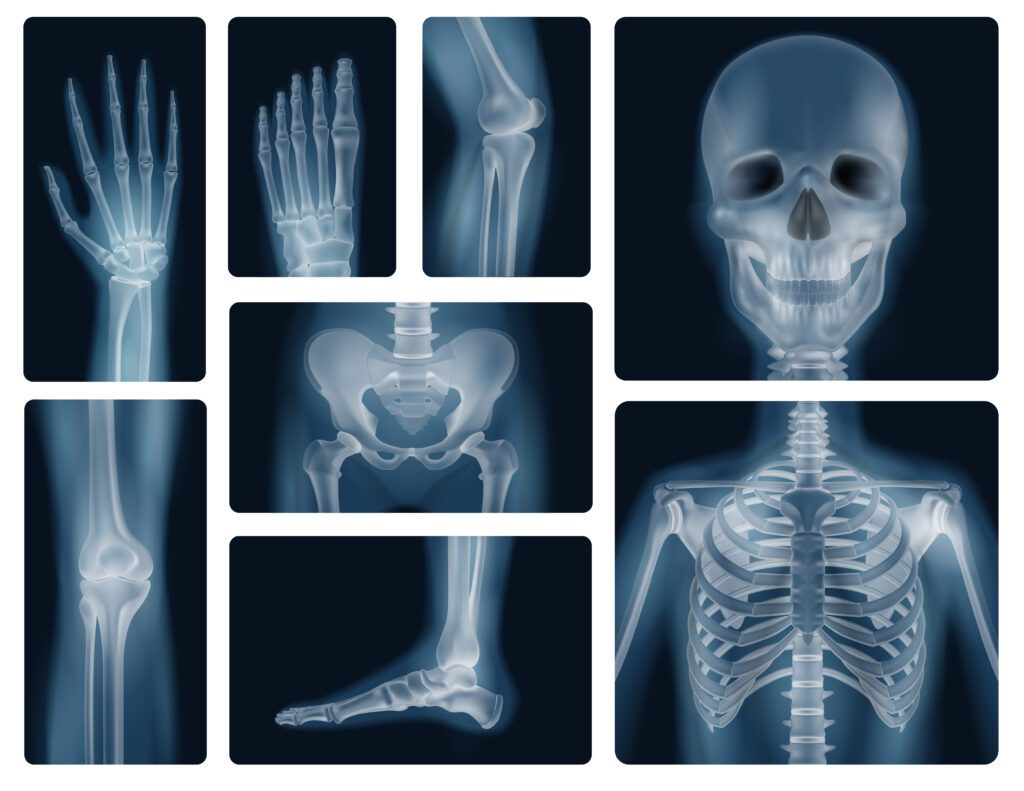
Skeletal surveys comprise a series of plain X-rays of the entire body to search for bone lesions that could be concerning for malignancy, particularly in multiple myeloma. Myeloma bone lesions are lytic and can be seen as destructive lesions or “punch-out” lesions. The main condition in which skeletal surveys are used is multiple myeloma. However, the sensitivity of skeletal surveys is low and has been replaced with other imaging modalities such as the low-dose whole-body CT scab and whole-body MRI when they are available.
Doppler Ultrasonography
Regular ultrasonography is frequently utilized in hematology, for example when assessing or monitoring spleen size. Doppler ultrasonography is an important test for the assessment of venous thromboembolism. It is cheap and readily available as it is a non-invasive test. It utilizes sound waves to visualize blood flow within the veins and detect abnormalities indicative of thrombus formation. Doppler ultrasound can identify the location, extent, and characteristics of the thrombus, aiding in treatment planning and risk stratification. It is crucial to understand in which vein is the clot located and differentiate between superficial and deep vein thrombosis as treatment can vary. Furthermore, assessing how close a clot is located from the deep venous system can aid with anticoagulation recommendations as well. Its sensitivity and specificity for detecting proximal DVT may vary depending on operator expertise, patient characteristics, and technical factors.
We hope this information is helpful! Please, leave your comments or questions below. Please rate our post using the star system below if your time allows. Thank you for reading!

